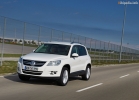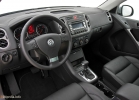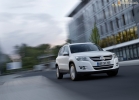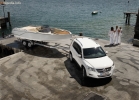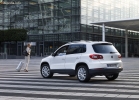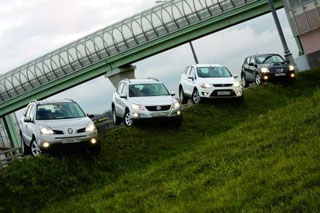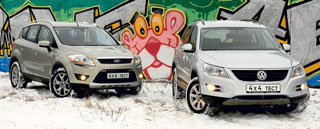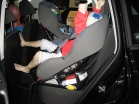Volkswagen Tiguan test drive since 2008 SUV
In the spirit of time
So, recently it happened that the absence of a serious blow in the line of the compact crossover on the reputation of any self -respecting automotive industrySo the Ford European branch was hastily mastering a new niche, releasing Kuga, and the Volkswagen concern to complement the model range of small Tiguan. It seems that the founder of this Toyota segment, which gave the RAV4 world, is just right to be guarded.
The Maverick in Ford began to catch up with the lost Europeans rejected by the Europeans with the American UAH BACK back in 2005. A year later, the podium of the Parisian car dealership adorned the kinetic concept of IOSIS X. Frankfurt-2007 became the place of premiere of the pre-production model. And the serial version of the first Ford of Europe in the history of the compact crossover Kuga saw the light at the beginning of this year.
They did not sit back in Volkswagen. Having firmly decided to repeat the success of Touareg on parquet off -road, the Germans approached the creation of a compact crossover with their inherent thoroughness. For the development of new items, they spent as many as four years. Even the general public was attracted: the name of the promising model was determined by almost popular voting. The promising hybrid Tiguan Tiguan won by a majority vote. Under this name, the car was presented to the public in 2006 at the salon in Los Angeles (then as a concept). The next year, Geneva showed a pre -production version. Tiguan went to the series this year. And since the summer, its large -sized assembly at the Russian VW plant in Kaluga has been mastered.
Against the backdrop of newcomers, the Toyota crossover is a real veteran sedentized by gray hair. That is how it is. After all, the first RAV4 was born in the last century, in 1994, becoming the ancestor of this so popular segment.
There were no today's rivals today, and the Japanese already developed the third generation of RAV4 with might and main, which debuted in the Russian market in early 2006.
However, outwardly, the third-generation car is practically no different from the predecessor of the model of the year 2000. Preserving the previous forms and proportions, the popular crossover has become a little larger and therefore looks more solid.
Especially against the background of rivals, to apply a solid epithet just does not rise.
Here is a swift, dynamic, ultramodern one please. And the solidity in the guise of Kuga and Tiguan, by golly, no. Both typical products of their time. Victims of total unification, which traces literally in everything: from design to used nodes and assemblies. The Ford crossover is perhaps the most kinetic and expressive model in the company's line-in-law has some kind of personality. And Tiguan on the side of Touareg, behind Golf Plus.
No more originality in interiors. The German crossover practically copies the same Golf Plus (with an admixture of Touran), and the lucky owner of Kuga, who has crossed the fashion of a fashionable new product with a conventional Focus or Focus C-Max, will also feel at home. Of course, Rav4 did not do without copying family features. But its expressive two -story front panel is definitely more distinctly than that of competitors.
There were no serious punctures in ergonomics of experimental machines. Thanks to a fairly wide range of vertical and horizontal adjustments of the seat and the ability to set up a steering column not only in the corner of the inclination, but also in departure (by the way, for the Japanese car this property is almost unique), for the lambs of our heroes it will be convenient for drivers of almost any height and complexion. Problems can occur only in very high people.
Well, what is the passengers? Alas, none of our heroes can boast in the back seats.
In principle, the three of them can be assured, but together it will not be more comfortable for an example. Okay, at least the legs are in abundance. Perhaps the best things are with Kuga, noticeably superior to competitors in the size of the wheelbase. Even a person is noticeably higher than the average height so that a good 5 cm remains to the backs of the front seats. True, unlike Toyota and VW, the Ford crossover does not offer the rear seats adjustable in horizontal, which greatly facilitate the search for a compromise between the comfort of passengers and the luggage space for luggage .
By the way, a few words about trunk. In the presence of passengers in the rear seats, Toyota offers the most useful volume. And you need to load the car for the eyeballs of the chair are folded literally in one movement. Moreover, it is convenient to do this both from the cabin and from the trunk, where special handles are provided. The thoughtful system of transformation of the salon (when ordering an optional reconciliation, the rear seats are folded into the floor) and Tiguan is also available. At the same time, the pillows of the pillows do not interfere with the front chairs back, as happens in Kuga using the AL FOCUS scheme. And the advantage of Ford in the opening glass (what is the glass of the whole upper section) of the fifth door: light things can be loaded directly through the window.
Well, it's time to check what our heroes are on the go. Buyers RAV4 are offered two gasoline engines: a 2-liter 152-horsepower, which allows you to choose between a 5-speed mechanics and a 4-speed automatic, and a 2.4-liter 170-horsepower, aggregated only with AKP-4. Only a 2-liter 136-horsepower diesel diesel with a 6-speed manual gearbox is available to customers, but the dealers seem to have begun to take orders for a 2.5-liter 200-horsepower gasoline turbo engine (this version can be equipped with automatic transmission 5).
The German crossover is still sold only with gasoline engines. You can buy a Tiguan with a 2.0 TSI engine (170 hp) and AKP-6 or prefer a 1.4-liter version with a 6-speed mechanics.
Under the hood of our Tiguan there was just such a motor. This engine with a secret. Thanks to double turbocharging, it was removed from him as many as 150 horsepower. Therefore, Tiguan accelerates great: you will not have time to come to your senses, and on the speedometer already a cherished hundred. Transigns are switched with weapons clarity (you only need to adapt to a very short first).
I liked Kuga, who literally struck the harmony of the components of the power unit. The moment diesel picks up from the bottom, and the box pleases not only with the clarity of switching, but also with a thoughtful selection of gear rates.
The modernized RAV4 automatic machine is booming (by the way, the mechanical transmission is configured and executed very well). However, I do not want to twist the engine: after 4000 rpm, it becomes too noisy.
In general, our heroes can quickly ride. And not only in a straight line. Competent chassis settings, electronic assistants and proper rubber allow you to pass turns with the highest possible speed.
The all -wheel drive transmissions of our heroes are implemented according to a single scheme: the electrohydraulic multi -disc council of Haldex transfers part of the traction to the rear wheels when slipping the front (in the first two generations, RAV4 was equipped with a constant full -wheel drive). In addition, each has a more or less capacious arsenal of electronic support for off -road. The easiest way to the Kuga driver, where the anti -boom electronics are activated automatically. A person can only work with his head, steering wheel and pedals. The steering Toyota can independently block the coupling or activate the regime of the descent assistant from the mountain. In Tiguan, it is enough to press the ONROD/OFFRAD button. At the same time, the gas reactions are softened, the aid system is turned on when lifting/descent, and a short -term wheel lock is allowed.
However, our heroes, of course, are far from real crooks: there is no reducing series in the transmission, and geometric patency leaves much to be desired (though Tiguan is also offered with an adapted bumper that provides an angle of entry of 28 degrees against ordinary 18).
It remains only to add that for the basic Ford Kuga dealers ask for from 881,000 rubles. The Japanese crossover will cost at least 901,000 rubles. And the most affordable VW Tiguan will facilitate a pocket of 904,000 rubles.
Crash test Ford Kuga
In the series of Krash-tests of the EURONCAP Association, the compact crossover Ford Kuga earned a 5-star rating, receiving 33 points. In an imitation of the front collision, the car was awarded 13 points. Experts noted the insufficient pressure in the pillow of safety, which can lead to injury to the driver's head. Kuga received 16 points for the lateral blow, and then there were no comments. The safety of children in the cabin (4 stars out of 5) was no less highly evaluated. For loyalty to pedestrians, the car received 3 stars out of 4.
Toyota Rav4 crash test
The Toyota compact book of the EURONCAP association in 2006 was first held. Experts awarded RAV4 at 4 stars. The car earned 32 points, 12 of which fell on the front hit and 16 on the side (2 more points were charged for the alarm about the unsteady seat belts and, according to the results of the side impact on the pillar). The safety of children in the cabin (39 points or 4 stars out of 5) was equally highly evaluated. In tests for pedestrians safety received 21 points or 3 stars out of 4.
Crash test VW Tiguan
In the EURONCAP tests, the German crossover was awarded a 5-star rating, gaining 34 points: 14 in imitation of the front collision and 16 with a side strike (4 more points Tiguan received alarm about the unhealthy seat belts and, according to the results of a side hit on the pillar). Experts noted the potential danger of the steering column for the driver's legs. The car protects young passengers for four 39 points. And experts rated the safety of pedestrians at 17 points or 2 stars out of 4 possible.
Andrey Tsybulsky
Photo author: Armen Meetarjyan
A source: Mkobil magazine [September/2008]
VOLKSWAGEN TIGUAN VIDEO VIDEO COMPANY since 2008
VOLKSWAGEN TIGUAN Crash Video since 2008
Volkswagen Tiguan test drives since 2008
Volkswagen Tiguan crash test since 2008
Krassh Test: Detailed Information34%
Driver and passengers
17%
Pedestrians
39%
Children-passengers

